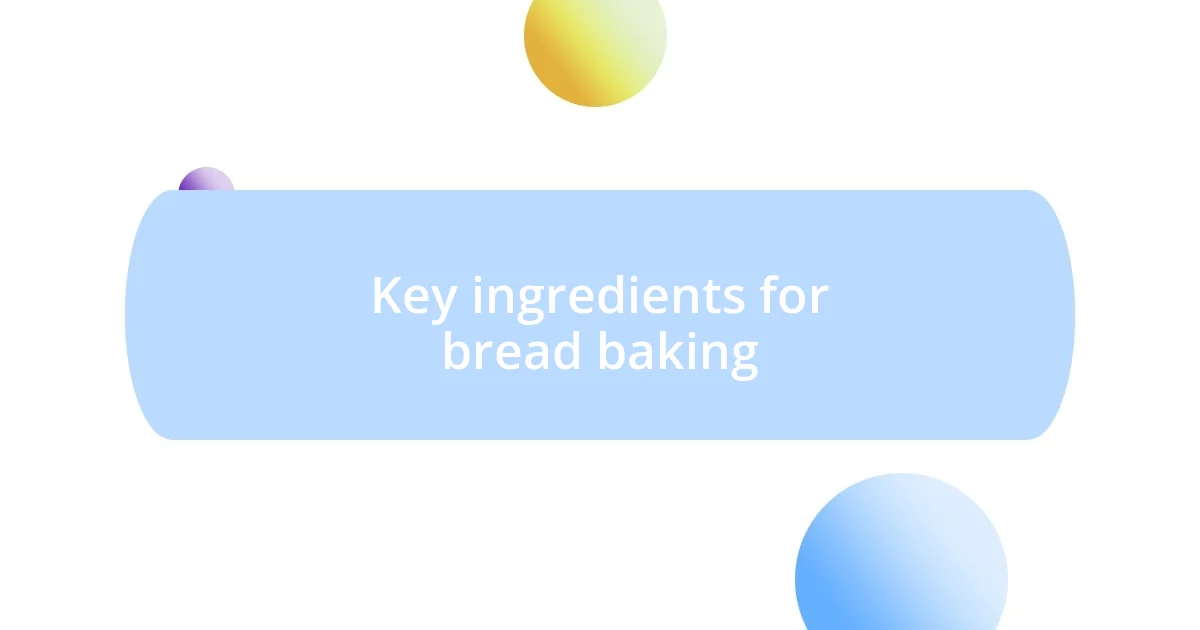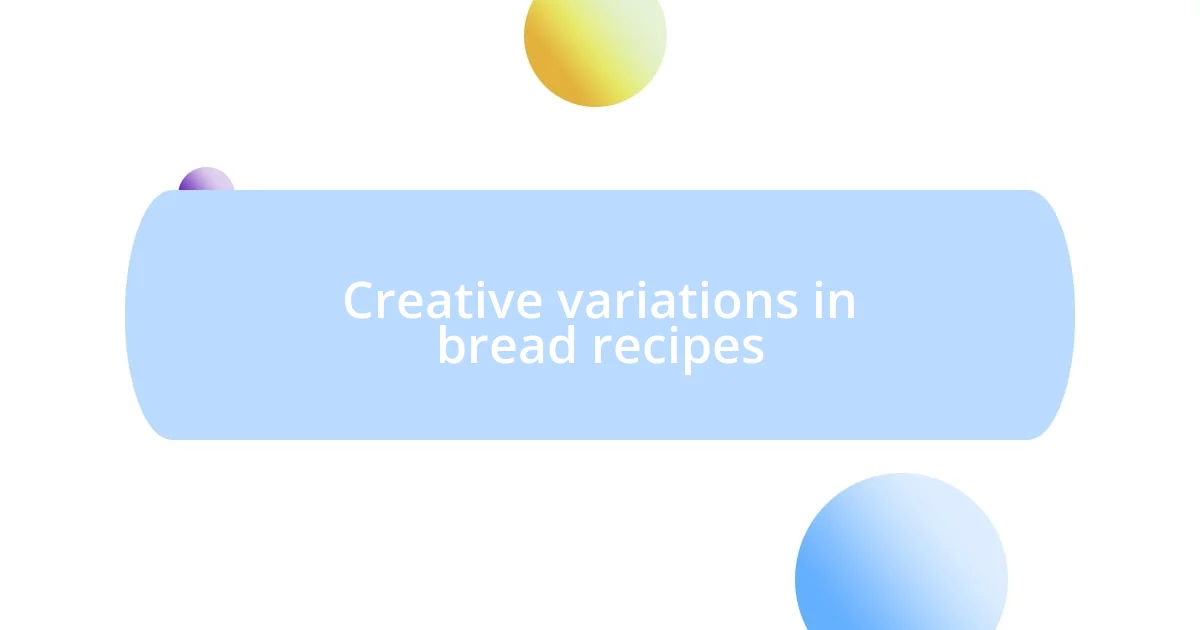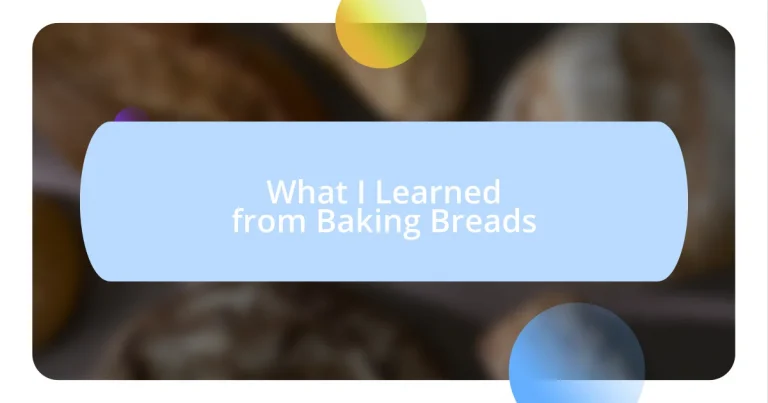Key takeaways:
- Choosing the right flour (e.g., bread flour) significantly impacts bread texture and chewiness.
- Patience during fermentation is crucial; longer fermentation enhances flavor and texture.
- Experimenting with ingredients and techniques (like adding steam or herbs) can lead to delightful variations in bread recipes.

Key ingredients for bread baking
Flour is the backbone of any bread recipe, and choosing the right type can change the game entirely. I still remember the first time I swapped all-purpose flour for bread flour—what a difference! The higher protein content gives the bread structure and chewiness, transforming a simple loaf into something truly special. Have you ever noticed how a good crust can elevate your bread from ordinary to extraordinary?
Then there’s yeast, the magical organism that makes our dough rise. I often find myself pondering its importance—not just as a leavening agent, but as a symbol of patience and nurturing in the baking process. I once made a batch of dough and forgot about it for hours, only to find it had risen beautifully. It was a humbling reminder that great things take time. Have you experienced the joy of watching dough transform before your eyes?
Finally, let’s talk about water. Not just any water; the temperature is crucial. Too hot, and you’ll kill the yeast; too cold, and it won’t activate. I vividly recall a bread-making mishap where I used boiling water thinking it would help the yeast along. The dough fell flat, and I felt defeated. It taught me how pivotal this simple ingredient is—not just for hydration, but for balancing all the other elements in our dough! How often do we overlook such a fundamental component, missing out on the potential it holds?

Techniques for perfect bread texture
Getting the perfect bread texture often hinges on a few tried-and-true techniques that can genuinely elevate your baking game. One of my favorites is kneading—it’s therapeutic in a way, connecting you to the dough. I’ve learned that kneading not only develops gluten, creating that desirable elasticity, but also allows you to feel the dough’s transformation as it goes from a sticky mixture to a smooth, pliable ball. It’s a bit like a dance; the more you practice, the more in tune you become with the rhythm of the dough.
- Knead effectively: Aim for a smooth, elastic texture, and don’t be afraid to get your hands dirty.
- Use a dough hook: If your mixer has this attachment, it can save time and energy while still giving you a consistent knead.
- Pay attention to hydration: I’ve found that a higher hydration dough can yield a more open crumb structure, giving your bread that artisanal look.
After kneading comes fermentation. Allowing your dough to rise correctly creates air pockets that significantly influence texture. I recall a time when I rushed through the first rise, excited to bake but ended up with a denser, less airy loaf. Now, I appreciate the power of patience—instead of glancing at the clock, I watch the dough respond. It’s like a waiting game where the reward is a perfectly light and airy crumb.
- Utilize bulk fermentation: Letting your dough rise slowly enhances flavors while creating a complex texture.
- Consider stretch and folds: This technique helps develop strength in the dough without heavy kneading.
- Control the temperature: Warmer environments speed up fermentation; sometimes, simply moving my dough to a warmer room has made all the difference.

Understanding fermentation processes
Understanding the fermentation process is pivotal in baking bread, as it’s during this stage that the dough truly comes to life. I’ve experienced that magical moment when dough begins to puff up, a clear sign that fermentation is working its wonders. The yeast feeds on sugars, producing carbon dioxide and alcohol, which not only makes the dough rise but also affects the flavor—creating that delightful tang we all love. It’s fascinating how patience can become an ally here; I’ve learned that walking away and letting the dough relax can yield better results.
As fermentation progresses, I’ve found that temperature plays a crucial role. There was a time I forget about a batch resting in a warm spot; it doubled in size much faster than I expected. While it was thrilling to see such rapid growth, the resulting bread was slightly over-proofed. This taught me that controlling the environment is just as important as the ingredients themselves. Now, I always keep a close eye on the ambient temperature, knowing it can make or break my baking experience.
The duration of fermentation is also a key factor. I’ve experimented with both short and long fermentation times, and each has its benefits. A long fermentation allows deeper flavors to develop, while a quick rise can save time. However, I remember making a loaf that had the flavors of my favorite sourdough simply by allowing it to ferment overnight in the fridge. This experience truly opened my eyes to the magic of time and temperature in baking, reminding me of the patience and skills we can cultivate through practice.
| Type of Fermentation | Characteristics |
|---|---|
| Short Fermentation | Quick rise, lighter flavor, suitable for quick breads |
| Long Fermentation | Enhanced flavor profile, more complex texture, often used in artisanal breads |

Tips for troubleshooting common issues
It seems like you’re really diving deep into the baking experience! Let’s discuss troubleshooting common issues you might encounter along the way.
One of the first signs you may notice is if your bread isn’t rising well. I’ll never forget the disappointment of pulling a flat loaf from the oven—what a letdown! Usually, this happens when the yeast is either old or the water is too hot. Remember, a quick test is to mix a teaspoon of sugar with warm water. If yeast bubbles up after a few minutes, you’re in good shape! If not, it’s a clear sign to get fresh yeast.
Another common challenge is a dense or gummy crumb. I experienced this firsthand with a batch of whole wheat bread that turned out more like a brick than a loaf. This often means your dough was too wet or might have over-proofed. A good rule of thumb is to keep an eye on the dough, and trust your instinct over the clock. If you tap on it and it springs back, you’re likely good to go!
Lastly, you might encounter bread that comes out too hard or crusty. While a crispy crust can be heavenly, there’s a fine line! I learned that adding steam during the baking process makes a world of difference. Just a few ice cubes tossed into the oven can create the steam needed for that perfect crust. Have you ever tried this method? It transforms the texture and can elevate your baking game!

Creative variations in bread recipes
Exploring creative variations in bread recipes has truly expanded my baking horizons. I remember trying a pumpkin bread recipe, and I was amazed at how the addition of spices like cinnamon and nutmeg transformed the flavor entirely. It felt like autumn in my kitchen! Have you ever considered how a simple ingredient swap can lead to entirely new experiences?
One time, I decided to experiment with herbs and cheese in my focaccia. The aroma of rosemary and garlic wafting through my home was intoxicating. I was surprised to see how the herbs not only elevated the taste but also brought an inviting visual appeal to the bread. It left me wondering; how often do we stick to traditional recipes instead of venturing into creative territory?
Then there’s the delightful world of sweet breads. I once baked a banana bread using Greek yogurt instead of butter, and the result was a moist, tangy treat that had everyone raving. I’d never have thought that a healthier twist could deliver such rich flavor. This taught me that flexibility in recipes could lead to healthier alternatives without sacrificing taste. What variations have you tried that brought unexpected joy?

Reflections on personal baking journey
Baking has been a journey of self-discovery for me. I remember the first time I shaped a loaf; it felt clumsy, but there was a certain joy in getting my hands floury. Each attempt has brought a blend of frustration and triumph, teaching me that patience can yield delicious rewards. Have you ever felt that mixture of emotions while baking?
There was a time when I accidentally swapped salt with sugar in a recipe. The result was an unforgettable, albeit inedible, disaster! But it illuminated how such small choices can dramatically alter the outcome. This moment made me reflect on the importance of attention to detail and mindfulness in the kitchen. It’s fascinating to consider how baking can mirror life—sometimes, a little misstep leads to the most memorable lessons.
In my baking pursuit, I’ve found that each loaf tells a story. I still relish the memory of trying my grandmother’s sourdough recipe—an heirloom of sorts. As the dough fermented, it felt like a connection across generations, full of love and tradition. Have you ever baked something that transported you back to a cherished memory? It’s these connections that make the journey all the more meaningful.














